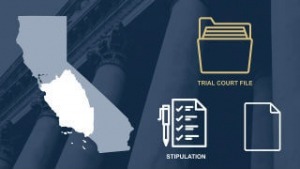Designating the Record
Designating the record on appeal is one of the most important steps in the appeal process.
The trial court keeps a record of everything that happens in a case. It is the appellant’s job to look through the trial court record and choose what materials to send the Court of Appeal for review. This process is called designating the record on appeal.
What’s in the trial court record? The trial court record includes evidence, testimony, motions, orders, and all of the other documents filed in the trial court during the case.
What’s in the record on appeal? The record on appeal is the portion of the original trial court file that is sent to the Court of Appeal. There are some materials that must be included in the record on appeal – like the judgment or order being appealed. The parties can add other materials that support their side of the case.
Why is designating the record on appeal so important? The Court of Appeal needs a record of what happened in the trial court to decide if the trial court made a legal mistake.
Even though the Court of Appeal makes a decision based largely on what they read in the record on appeal, the trial court does not automatically send the Court of Appeal a copy of the whole trial court record for a case.
The Court of Appeal only receives the parts of the trial court record designated or chosen by the parties. Also, the parties can only refer to information in the record on appeal when they make their legal arguments to the Court of Appeal. That’s why it’s important for the parties to choose parts of the trial court record that support their arguments for or against the trial court’s decision.
Who designates the record on appeal? The appellant is required to designate the record on appeal first. Then the other parties have an opportunity to designate the record on appeal, but it is not required.
When does the appellant designate the record on appeal? In most cases, the appellant only has 10 days to designate the record on appeal. The 10 days start when the appellant files their notice of appeal with the trial court. The deadline may be extended if the case is being considered for mediation.
How does the appellant designate the record on appeal? Is there a court form? The appellant generally uses form APP-003 to designate the record on appeal. On the form, the appellant lists documents, oral proceedings, and other materials to include in the record on appeal that is sent to the Court of Appeal. The appellant must serve a copy of the form to all other parties in the case, then file the original form and proof of service with the trial court.
How much does it cost? It can be expensive to prepare the record on appeal. There are separate costs to prepare the documents and the oral proceedings. If the appellant has a fee waiver, there is no cost for the trial court to prepare documents. However, there is generally a fee to prepare a reporter’s transcript of what was said.
When can the other parties add to the record on appeal? Is there a court form? After the appellant files notice designating the record on appeal, the other parties have 10 days to review it. The other parties can use form APP-010 to add items from the trial court record to the record on appeal. The other parties should include all the information that supports their side of the case.
What happens next? The trial court prepares the record on appeal and sends it directly to the Court of Appeal. The trial court either mails the appellant their copy of the record on appeal or sends notice to the appellant when their copy of the record on appeal is ready for pick up. If another party ordered a copy of the record on appeal, they also receive their copy in the mail or receive notice to pick it up at the trial court.
After the record on appeal is filed with the Court of Appeal, the parties receive notice telling them when the appellant’s opening brief is due.
Learn more about designating the record on appeal
Watch a step-by-step video on how to designate the record on appeal.


